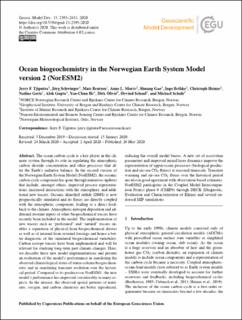| dc.contributor.author | Tjiputra, Jerry | |
| dc.contributor.author | Schwinger, Jörg | |
| dc.contributor.author | Bentsen, Mats | |
| dc.contributor.author | Morée, Anne | |
| dc.contributor.author | Gao, Shuang | |
| dc.contributor.author | Bethke, Ingo | |
| dc.contributor.author | Heinze, Christoph | |
| dc.contributor.author | Goris, Nadine | |
| dc.contributor.author | Gupta, Alok Kumar | |
| dc.contributor.author | He, Yan-Chun | |
| dc.contributor.author | Oliviè, Dirk Jan Leo | |
| dc.contributor.author | Seland, Øyvind | |
| dc.contributor.author | Schulz, Michael | |
| dc.date.accessioned | 2020-09-18T12:22:32Z | |
| dc.date.available | 2020-09-18T12:22:32Z | |
| dc.date.created | 2020-05-26T16:00:20Z | |
| dc.date.issued | 2020 | |
| dc.identifier.citation | Geoscientific Model Development. 2020, 13 (5), 2393-2431. | |
| dc.identifier.issn | 1991-959X | |
| dc.identifier.uri | https://hdl.handle.net/11250/2678507 | |
| dc.description.abstract | The ocean carbon cycle is a key player in the climate system through its role in regulating the atmospheric carbon dioxide concentration and other processes that alter the Earth's radiative balance. In the second version of the Norwegian Earth System Model (NorESM2), the oceanic carbon cycle component has gone through numerous updates that include, amongst others, improved process representations, increased interactions with the atmosphere, and additional new tracers. Oceanic dimethyl sulfide (DMS) is now prognostically simulated and its fluxes are directly coupled with the atmospheric component, leading to a direct feedback to the climate. Atmospheric nitrogen deposition and additional riverine inputs of other biogeochemical tracers have recently been included in the model. The implementation of new tracers such as “preformed” and “natural” tracers enables a separation of physical from biogeochemical drivers as well as of internal from external forcings and hence a better diagnostic of the simulated biogeochemical variability. Carbon isotope tracers have been implemented and will be relevant for studying long-term past climate changes. Here, we describe these new model implementations and present an evaluation of the model's performance in simulating the observed climatological states of water-column biogeochemistry and in simulating transient evolution over the historical period. Compared to its predecessor NorESM1, the new model's performance has improved considerably in many aspects. In the interior, the observed spatial patterns of nutrients, oxygen, and carbon chemistry are better reproduced, reducing the overall model biases. A new set of ecosystem parameters and improved mixed layer dynamics improve the representation of upper-ocean processes (biological production and air–sea CO2 fluxes) at seasonal timescale. Transient warming and air–sea CO2 fluxes over the historical period are also in good agreement with observation-based estimates. NorESM2 participates in the Coupled Model Intercomparison Project phase 6 (CMIP6) through DECK (Diagnostic, Evaluation and Characterization of Klima) and several endorsed MIP simulations. | |
| dc.language.iso | eng | |
| dc.rights | CC BY 4.0 | |
| dc.rights.uri | https://creativecommons.org/licenses/by/4.0/ | |
| dc.title | Ocean biogeochemistry in the Norwegian Earth System Model version 2 (NorESM2) | |
| dc.type | Peer reviewed | |
| dc.type | Journal article | |
| dc.rights.holder | © 2020, Authors | |
| dc.description.version | publishedVersion | |
| cristin.ispublished | true | |
| cristin.fulltext | original | |
| cristin.qualitycode | 2 | |
| dc.identifier.doi | 10.5194/gmd-13-2393-2020 | |
| dc.identifier.cristin | 1812715 | |
| dc.source.journal | Geoscientific Model Development | |
| dc.source.volume | 13 | |
| dc.source.issue | 5 | |
| dc.source.pagenumber | 2393-2431 | |
| dc.relation.project | Notur/NorStore: nn9560k | |
| dc.relation.project | Norges forskningsråd: 295340 | |
| dc.relation.project | Norges forskningsråd: 270061 | |
| dc.relation.project | Notur/NorStore: ns9560k | |
| dc.relation.project | Notur/NorStore: ns1002k | |
| dc.relation.project | Notur/NorStore: nn1002k | |
| dc.relation.project | Notur/NorStore: nn2980k | |
| dc.relation.project | Trond Mohn stiftelse: BFS2018TMT01 | |
| dc.relation.project | Notur/NorStore: ns2980k | |
| dc.relation.project | Norges forskningsråd: 229771 | |
| dc.relation.project | Notur/NorStore: ns2345k | |
| dc.relation.project | Notur/NorStore: nn2345k | |
| dc.relation.project | EC/H2020/641816 | |
| dc.relation.project | Norges forskningsråd: 295046 | |
| dc.relation.project | Norges forskningsråd: 275268 | |

